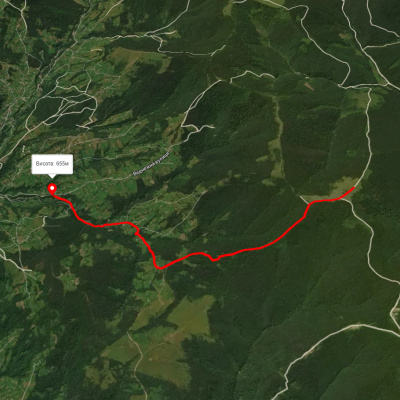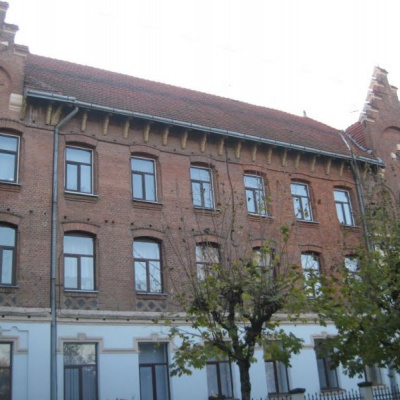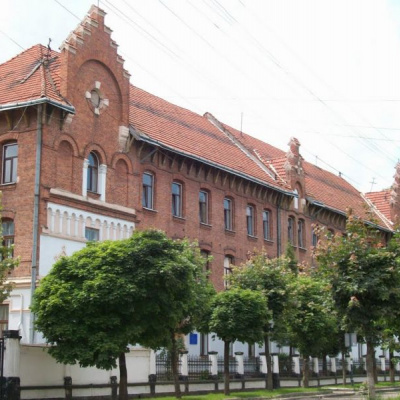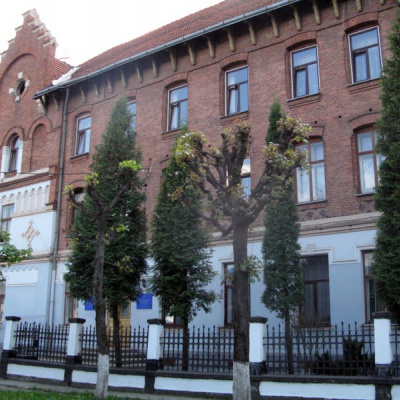Mykhailo Hrushevsky Gymnasium (Ursuline Monastery), Kolomyia
The path to the opening of the Ukrainian gymnasium in Kolomyia was difficult and thorny. The opening of a Ukrainian gymnasium in Galicia was hindered by an anti-popular regional law of June 22, 1867: a Ukrainian gymnasium could be founded only with the permission of the Polish majority of the Galician Sejm and the district council (which was also dominated by Poles). In March 1882, the Galician Sejm discussed a petition by Ambassador D. Savchak to open a Ukrainian gymnasium in one of the cities: Chortkiv, Buchach, or Kolomyia. The following decision was made: "The specified place for the foundation of such a (Ukrainian - R.A.) gymnasium is Kolomyia. This is supported not only by the statement of the Kolomyia Poviat Council and the geographical location, but also by the fact that there is a Polish gymnasium in that city, so Polish and Ruthenian youth will have the opportunity to establish mutual and very covetous relations."
On March 30, 1892, the deputies of the Galician Sejm approved this decision to open the gymnasium in the 1892/93 academic year by a majority vote. On September 7, 1892, the Lvivska Gazeta reported: "His Majesty the Emperor has decided by his highest decree of September 4, 1892, to most graciously allow the gradual establishment of a gymnasium with the Russian language as the medium of instruction in Kolomyia."
The deadline for enrollment was set for September 15. But unexpectedly, difficulties arose with enrollment. In addition, the principal of the Polish gymnasium, J. Skupniewicz, complicated the matter. To settle the matter, the regional school board sent inspector Ivan Levytskyi to Kolomyia. Forty-three pupils were enrolled in the first gymnasium class. On September 21, the Ukrainian gymnasium class was inaugurated, and classes began the next day.
The public demanded that Ukrainian classes be separated from the Polish gymnasium. On September 4, 1894, the Vienna Ministry of Education appointed Sofron Niedielski (1857-1917), a teacher at the Stanisławski Polish Gymnasium, as the head of the Ukrainian classes. On March 9, 1900, the Viennese Ministry ordered the opening of an "independent Ruthenian (Ukrainian - R.A.) gymnasium with the beginning of the school year 1900/01." Sofron Nedilskyi was appointed director of the gymnasium. The gymnasium moved to its own premises. The northern side of the existing gymnasium building was completed.
The Ursulines are a Catholic monastic congregation founded in 1535 and founded in Italy by Angela Merici. Initially, the congregation was a nunnery. In it, young girls, having devoted their lives to the service of the Lord, remained in secular society and pledged to live in poverty and chastity. Their main duties were to establish schools and orphanages for girls, as well as to educate them in a way that did not go beyond the Catholic canons.
According to legend, St. Ursula lived in the late 4th century and was the daughter of King Corumbus. Despite her unearthly beauty, she devoted herself to God. The walls of the old building in the center of Kolomyia, built in 1907, originally housed a monastery of Ursuline sisters. Today, the premises of this building house the most prestigious gymnasium in Kolomyia, named after Mykhailo Hrushevsky.
The three-story building of the main building of the former Ursuline Sisters' monastery is monumental, but at the same time elegant, striking in its grandeur, harmony, and well-groomedness. The Ursuline sisters did not limit their work to religion and education. They were also engaged in gardening. The garden they planted still gives its fruits to the students of the gymnasium.
In 1892, during the Galician Council, its representatives documented a resolution to establish a Ukrainian gymnasium in the city. A Ukrainian class was created at the already existing Polish one. The famous writer Vasyl Stefanyk spent his school years in this gymnasium. In 1900, at the insistence of public organizations, Ukrainian classes were separated from Polish ones. In 1939, the Ukrainian gymnasium was closed, and a secondary school began to operate here instead. And in 1990, the regional executive committee decided to revive the city gymnasium with a humanitarian bent. It was then that it was placed in the buildings of the former monastery ensemble, where a private women's gymnasium had already been operating before the war.
"School is our second home." We are accustomed to these words, and we speak with admiration and love, with pride about the school where we, our children, studied, and about the educational institution where we work. At all ages, schools have one vocation - to teach. A teacher remains a teacher at all times. Life requires an intellectually developed personality and, at the same time, a tolerant one, open to democratic communication and development in the national and international dimension. To be able not only to create, but also to share what has been done with colleagues from other educational institutions - this was the goal set by the management of the Kolomyia Hrushevsky Gymnasium when it took part in the All-Ukrainian competition "100 Best Schools of Ukraine".
There are 22,000 schools in Ukraine that have their own creative achievements, best practices, and uniqueness. The competition was attended by 1887 schools from all regions of Ukraine. The teachers of the gymnasium supported the idea to take part in the competition, because this school has a lot to boast about. This includes participation in various city, regional, and national competitions, in the Panorama of Creative Lessons, the productive work of the publishing center, which publishes teachers' manuals, participation in international programs for teachers and students, holding open lessons for educators of the city, region, and region, "Master Classes," publishing the best lesson notes in national educational newspapers and magazines, and so on. If we want to move towards quality education, we need to show that it can be in our city.
The tasks of this educational institution are aimed at transforming the knowledge and means of activity that students master into the development of each individual. The educational process of the gymnasium is focused on the abilities, inclinations, needs and life plans of each student. The gymnasium responds in a timely manner to changes in society, strives to create the necessary conditions for the implementation of variable education within the school, and to ensure consistency at all stages of the students' education and development.
During the 2001-2005 academic years, about 350 prizes were won by the gymnasium students at city subject competitions, 64 at regional competitions, and 22 won the second and third stages of the competition for the defense of research papers of the Junior Academy of Sciences. Every year, the gymnasium's students win the Future Leaders of the United States competition, winning a year-long internship abroad in the United States. Former graduates are studying in Germany, the Netherlands, the United States, Poland, Belgium, Austria, and England. Former students Ivan Monolatii (history) and Myroslav Kavatsiuk (nuclear physics) have become PhDs.
Highly qualified teachers are able to organize fruitful interaction in the learning process in a creative environment. One Honored Teacher of Ukraine, 13 methodology teachers, and 14 senior teachers teach 460 students at the gymnasium. Teachers of the gymnasium regulate students' amateur activities, making a transition from reproductive to active creative activities. The gymnasium's methodological support allows it to work at the level of modern pedagogical technologies and effective teaching methods (such as problem-based learning, concentrated presentation of educational content, project-based learning, creation of heuristic situations, etc.) Teachers are authors of methodological manuals and programs, promoters of modern educational technologies, and publish poetry collections. They often give interesting and informative lectures to colleagues in the city and region, and hold open classes. The gymnasium organizes methodological decades, fairs of pedagogical ideas, and subject weeks ("My Methodological Finds", "Innovative Technologies in Modern Lesson Methods", etc.)
The gymnasium is not a traditional educational institution, but a new type of school where extraordinary personalities work. Today, the main goal of the school is not so much to teach a student as to learn how to work with him or her, to introduce children to the world of systemic, complex tasks that cover a wide range of information and allow a student to see, feel, and grasp the phenomena and processes taking place in education at the level of accurate intuition.
The competition has been held. Mykhailo Hrushevsky Gymnasium became one of the winners of the 100 Best Schools of Ukraine in the School of Modern Educational Technologies nomination. Work and mobilization of forces for new conquests of the heights lie ahead, because we are all creating a new school of Ukraine in the XXI century.
Accommodation around Mykhailo Hrushevsky Gymnasium (Ursuline Monastery), Kolomyia:
Які маршрути проходять повз Mykhailo Hrushevsky Gymnasium (Ursuline Monastery), Kolomyia?
Пропонуємо пройти такі туристичні (пішохідні) маршрути через/біля Mykhailo Hrushevsky Gymnasium (Ursuline Monastery), Kolomyia: Шешори - Росохата, Дорога опришків, с. Космач, через г. Ротило, г. Грегіт, г. Біла Кобила до с.Буковець, с. Микуличин, через г. Хорде, г. Ротило до с. Космач, ур. Медвежий - г. Куратул, пер. Німчич - Протяте Каміння

Шешори - Росохата
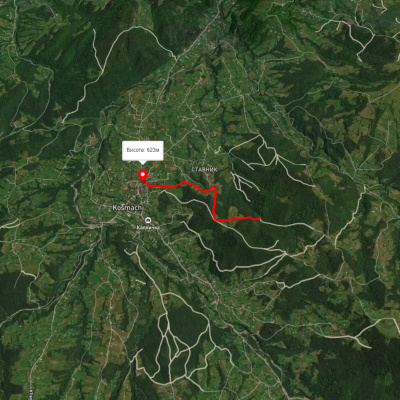
Дорога опришків
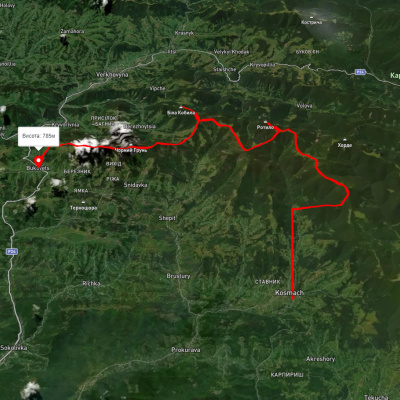
с. Космач, через г. Ротило, г. Грегіт, г. Біла Кобила до с.Буковець

с. Микуличин, через г. Хорде, г. Ротило до с. Космач
